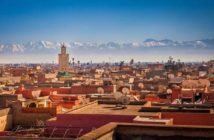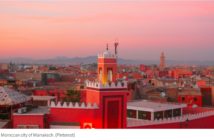Essaouira-Mogador occupies a unique place in the history of Morocco. This is largely based on the exceptional unity of social, philosophical and cultural relations between communities of diverse religious faiths. The High Atlas Foundation and its many local partners have initiated a preservation and maintenance program for the Moslem, Christian, and Jewish cemeteries in Essaouira, which stand as present-day reminders of the peaceful and prosperous coexistence of the past.
Essaouira has two Jewish cemeteries: the ‘old’ and the ‘new’. I was very privileged to visit them with Asher Knafo, poet, writer, and researcher of the history of Jewish Mogador. Asher explained to me that the Jews of Mogador were such a culturally rich society that there are several practices which existed only here. For example, the creation of illuminated ketubot (Jewish prenuptial agreements) or the inscription of linguistically complex poems on tombstones. His article, about the new Jewish Cemetery, « Heureux sois tu, pays aux nombreux fils et aux nombreuses tombes » explains what this poetry reveals about Jewish life in Mogador in the 19th and 20th centuries.
Asher is a Jewish Souiri himself. He left Morocco in 1951. He showed me his former house in the Kasbah (which is now a hotel) and the shop in the Kasbah where his father sold books and stationery (now a photography studio). His grandfather and great-grandfather, both prominent rabbis, are buried in the new cemetery. When we visited, Asher defied the infamous Essaouira wind to light a candle at the grave of his grandfather, Rabbi Yossef Knafo. I helped clean the grave of his great-grandfather, which was covered in evidence of Essaouira’s many seagulls!
Rabbi David Knafo, Asher’s grandfather, was the chief Rabbi of Essaouira and the rabbinical judge. He died in 1937. He is buried near his peers and friends – another two Davids: Rabbi David Elkaïm and Rabbi David Yflah. Both died in the early 1940s and both were lauded experts in their cultural and artisanal fields (as well as men of religion). David Elkaïm was a celebrated poet and stone mason. It was the fortuitous convergence of these skills which led to the rich poetry of Mogador epitaphs. He had many imitators in Mogador and never signed his works, but his work is recognisable to those who seek it and is considered the best example of Jewish epitaph inscription.
Rabbi David Yflah was a master of liturgical poetry. Many came to learn from him and the Andalusian style of music and song, of which he was a maestro, is still celebrated in an annual festival in Essaouira.
The tombs inscribed by Elkaïm and others take some deciphering. Their poems are not only of aesthetic and cultural significance, but they contain social information relating to the family, profession and situation of death. In addition, they provide historical information which helps us piece together information about life in Mogador in the 19th and 20th centuries. One grave we found, of a woman called Esther who died in 1940, revealed that the deceased’s father had been a consul of the Austro-Hungarian Empire. The inscriptions also contain riddles and codes. Extracts from verses of the bible are used as code to denote the Hebrew date of death (which then needs to be translated into the Gregorian calendar). In the case of Esther, chillingly, the letters of her own name revealed the date of her death.
I also noticed inscriptions of open palms on graves. This means that the deceased was descended from religious priests forefathers (Kohanim) who blessed the people in this fashion. I had seen stones placed on graves in other Jewish cemeteries and Asher explained that people place these to mark their passing. If the stone is still there when they return, it is considered to bring good luck.
We trekked into the heart of the cemetery where it is impossible to walk without treading on tombstones. We apologised to those upon whose graves we stood. Asher’s theory about the disorganised laying of the tombs in certain spots is that there was a typhus epidemic at one point where men and women died in greater quantities than had permitted more systematic burial. Elsewhere, I noticed many women’s graves grouped together – indication of a more conservative and orderly period where it was considered proper for women and men to be buried separately.
The cemetery also tells the stories of many great families of Mogador such as the Corcos, the most famous ‘Sultan’s merchants’ of Mogador and the Yuly and Levy families – some of whom are certainly ancestors of the first Jewish US senator, David Levy Yulee.
The two Jewish cemeteries (and the Haïm Pinto synagogue) are looked after by a Muslim woman, Malika, and her son. Malika’s family have been caretakers at thecemeteries for 4 generations. She told me how she recalled a vegetable garden in one corner of the cemetery where we funds from the US Ambassador’s Cultural Preservation Fund have enabled HAF to plant three large Washingtoni palms to offer some much needed shade. But the cemetery is too much for one family to maintain. The graves are so numerous and the land is so overgrown. In some areas, we can be sure there are graves, but we can’t see them for vegetation. An important part of the HAF project will be clearing, cleaning, planting and restoration in the cemeteries to make them more accessible and inviting for visitors.
In the meantime, however, Asher needs to clear some key graves to continue his work of photographing, copying, recording and analysing key historical tombstones.
Some of the best preserved are those which are covered in weeds and therefore not exposed to the unrelenting sun, wind, moisture (and seagulls!). We are very appreciative of assistance offered to us by the Governor of Essaouira and the Essaouira-Mogador Association in securing labourers to assist Asher in his work. He has come a long way from Israel to re-visit his roots. We are grateful to him and we want to ensure that he can use his time well to preserve the knowledge and history of the Jewish cemeteries.
About the Author: Lynn Sheppard is Project and Development Manager for the High Atlas Foundation’s cultural preservation initiative in Essaouira, Morocco, where she also lives.






